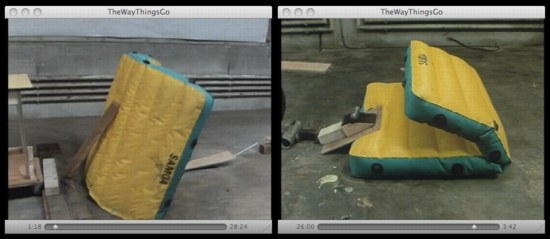Three coincident events have caused me to re-examine Der Lauf der Dinge (The Way Things Go), a thirty-one minute black-and-white film by Fischli & Weiss, which follows an unmanned chain reaction of low tech events orchestrated in their Zurich studio in 1987. In its broad object humor, material pathos, fanciful appetite for destruction and commitment to an inexorable linearity of cause-and-effect, it is often compared to the "machines" of the cartoonist Rube Goldberg.

First Event. A video of the piece, owned by MoMA in New York, is installed as an introduction to the new Artist's Choice exhibition at MoMA by artist Vik Muniz, entitled Rebus. It is projected in a third floor hallway, just outside the main galleries, as a prefatory comment or demonstration of Muniz's organizing thesis, suggesting the associated "chain" of sculptures, design objects, photographs, drawings, editions, installations and paintings, drawn from MoMA's collection, which he has selected and arranged within.
While the aesthetic cause-and-effect implied by Muniz is neither as linear nor as determined as in The Way Things Go, he does create many instructive continuities and discontinuities, formal similarities and purposeful confusions between "high art" and design objects. These playful double and triple takes, engendered in the audience, inform the entire exhibition and also echo strategies of the meta- which have been the subject of Muniz's own work for years. Interestingly, another F&W piece, Things from the Room in the Back, a room-sized installation from 1999, is also featured in its own separate space.
Second Event. News via Artforum.com that The Way Things Go "was sold last week for $860,000 at an auction held at the Zurich branch of Christie’s. While the film has been widely copied and distributed, the unnamed collector purchased the original reel along with a series of relics from the film set." The film had been on long term loan from the collection of Alfred Richterich to Kunsthaus Zürich, which was frankly surprised by the auction.
Third Event. Blogger extraordinaire Greg Allen recently posted on the sale of the film and on several points regarding its means of production. The pertinent questions include: How can one "own" a film that is readily available as a DVD, on sale for $15, and free online on YouTube? How did Richterich (heir to the Ricola cough drop fortune), who "pursued his family's tradition of collecting art and supporting various creative endeavors", come to possess an "original" print? Is it because he helped F&W fund the film, on which he is listed as co-producer? Did he receive a negative, a master print, and/or the two vitrines of ephemera (that are part of the recent Christie's Zurich sale) as compensation for his participation?
Moreover, the film itself, which has generally received critical praise as a tour de force of unedited, continuous action and uninterrupted forward motion, is anything but. According to Mr. Allen's analysis, there are 23 edits, plus re-used and re-staged props, including a particularly photogenic air mattress.

More tellingly, much of the action seems staged along the same strip of studio floor, rather than proceeding through the giant, continuous expanse of a factory. The mise-en-scene was set up, shot and dismantled, then the space was re-used for a new set up, shoot and dismantling, until the film was complete.
"The edits are clear, even obvious in places, and yet casual observers and critics alike appear to miss or ignore them, preferring the enjoyable spectacle of a 30-minute, non-stop trick ... A cynic could have a lot of fun with the idea that people choosing to believe something entertaining but self-evidently false is, in fact, The Way Things Go." Which is just one of the many puns on the title that Mr. Allen indulges in his fascinating dissection. He also cites a 2003 Honda Accord commercial by Portland, Oregon firm Weiden + Kennedy, based on the F&W film (a copyright infringement suit was threatened), which employed a full advertising budget and 606 takes to produce two minutes of unedited action (in fact there is still one well camouflaged edit) - this as an indication of how unlikely it would be for F&W to successfully stage 30 minutes of a continuous phenomenological miracle.
Here then, straight from YouTube for your viewing pleasure, is The Way Things Go:
via Christian Rattemeyer: Susan Inglett's current show
Christian Rattemeyer, curator of drawings at MoMA, indicates he "saw the video at its initial screening at Documenta 8, in 1987 in Kassel, and ... always thought of it as an edited work, never as a continuous chain reaction, but so much fun regardless".
He contributes another appropriate reference: Susan Inglett's current show, entitled "The Way Things Go", is inspired by the film. It includes work by Luca Buvoli, Buckminster Fuller, Fischli & Weiss, Rube Goldberg, Tim Hawkinson, Beom Kim, Mika Rottenberg, Greg Smith, and Phoebe Washburn.
From the press release:
I haven't seen the show yet,
and so am unaware whether it includes a presentation of the film itself.It does, a DVD projection in a back room, strangely accompanied by the muted voice of a Buckminster Fuller audio piece. The show is up through December 20.